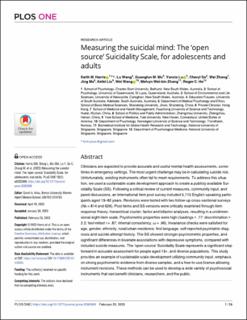| dc.description.abstract | Clinicians are expected to provide accurate and useful mental health assessments, sometimes in emergency settings. The most urgent challenge may be in calculating suicide risk. Unfortunately, existing instruments often fail to meet requirements. To address this situation, we used a sustainable scale development approach to create a publicly available Suicidality Scale (SS). Following a critical review of current measures, community input, and panel discussions, an international item pool survey included 5,115 English-speaking participants aged 13–82 years. Revisions were tested with two follow-up cross-sectional surveys (Ns = 814 and 626). Pool items and SS versions were critically examined through item response theory, hierarchical cluster, factor and bifactor analyses, resulting in a unidimensional eight-item scale. Psychometric properties were high (loadings > .77; discrimination > 2.2; test-retest r = .87; internal consistency, ω = .96). Invariance checks were satisfied for age, gender, ethnicity, rural/urban residence, first language, self-reported psychiatric diagnosis and suicide attempt history. The SS showed stronger psychometric properties, and significant differences in bivariate associations with depressive symptoms, compared with included suicide measures. The ‘open source’ Suicidality Scale represents a significant step forward in accurate assessment for people aged 13+, and diverse populations. This study provides an example of sustainable scale development utilizing community input, emphasis on strong psychometric evidence from diverse samples, and a free-to-use license allowing instrument revisions. These methods can be used to develop a wide variety of psychosocial instruments that can benefit clinicians, researchers, and the public. | en_US |

